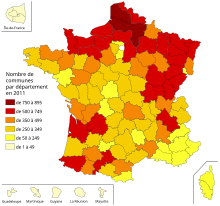Municipality (France)

In France , the municipalities ( French communes , singular commune ) below the regions and départements represent the lowest level of the Collectivités territoriales ( local authorities ), similar to the municipalities or political communities in German-speaking countries. There are a total of 35,416 municipalities on French territory (as of January 1, 2017). Most communities consist of a main town and several neighboring villages, hamlets ( hameaux ) and individual farms.
Territorial division
The self-government of the municipalities is independent of the higher regional authorities - the 18 regions and 101 départements - and the administrative subdivision of the départements into 333 arrondissements . The city of Paris , which is a municipality and a department at the same time, has a special position .
All municipalities in metropolitan France are completely part of a region, a department and - with the exception of Paris - an arrondissement of the relevant department.
The municipalities of Paris , Lyon and Marseille are divided into arrondissements , which have the function of urban districts and should not be confused with the arrondissements of the départements.
In addition to the motherland and the five overseas departments , most of the other overseas territories are also divided into municipalities. The only exceptions are Wallis and Futuna , which is made up of three kingdoms based on local traditions (royaumes coutumiers) , which in turn are divided into 36 villages, Saint-Barthélemy and Saint-Martin as well as the areas without permanent residents ( French Southern and Antarctic Territories and Clipperton Island ), which have no local government.
In 2013 there were a total of 36,681 municipalities on French territory, of which 36,552 were in European France and 129 in overseas territories . As of 2017, the total number of municipalities was 35,416. The number of independent municipalities in France is still very high compared to other countries, as no systematic municipal reform has taken place in the last 200 years .
Within some municipalities there are still Communes associées (for example: “associated municipalities” or “sub-municipalities”), a total of 730 as of 2006. They are formerly independent municipalities that still have limited independence within the new municipality.
In Eurostat's statistical zoning , the French municipalities (as well as the German ones) correspond to level LAU 2 . The communities are clearly identified by INSEE codes .
history
The communities emerged from the cities and parishes of the Ancien Régime and were institutionalized in 1789 after the French Revolution . In 1884 they were given extensive autonomy by a law on the election of the municipal conseil .
Organs of the community
Each municipality has a municipal council (Conseil municipal) , whose members are determined by direct election. He elects the mayor (maire) and his or her deputy (adjoint au maire) from among his ranks . The mayor has executive power , represents the community externally and manages the budget .
Community associations
Neighboring municipalities can join together to form a municipal association, which in France is known as Communauté urbaine , Communauté d'agglomération or Communauté de communes , depending on its size and status . In 2004 there were 14 communautés urbaines in France with a combined population of more than 6 million, 155 communautés d'agglomération with a combined population of more than 19 million and 2,286 communautés de communes with a combined population of almost 24 million.
literature
- Claude Motte et al. a .: Communes d'hier, communes d'aujourd'hui . INED, Paris 2003, ISBN 2-7332-1028-9 .
Web links
Individual evidence
- ↑ a b Code officiel geographique. Documentation. Institut national de la statistique et des études économiques , accessed on June 2, 2017 (French).
